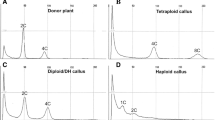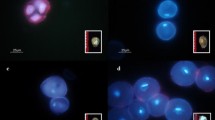Abstract
Sunflower anthers placed on solid medium developed calli and embryos after 12 days. Embryogenesis was improved by the addition of 0.1% polyvinylpyrrolidone (PVP) that alleviated anther and medium browning. As in other species, genotypic variability was an important parameter in the anther response and a medium genotype interaction was suggested with a different PVP effect depending on the genotype. Embryo germination was largely increased by the successive use of germination media with decreasing sucrose concentrations (10%⇒6%⇒3%). Histological examination of the anthers during the first ten days of culture showed that, under our conditions, the embryos were of somatic origin, arising directly from the anther wall on the outside or inside of the anther loculus, or indirectly from proliferating anther wall- or connective tissue-derived callus. Finally, the ploidy status of 78 embryo-derived plants was determined by Feulgen stain or flow cytometry: all plants were diploid (2n=34).
Similar content being viewed by others
Abbreviations
- PVP:
-
polyvinylpyrrolidone
References
Alissa A, Serieys H & Jonard R (1985) Sur les possibilités de régénération d'espéces sauvages et d'hybrides interspécifiques du genre Helianthus par androgénés in vitro. C. R. Acad. Sci. Paris 300: 25–30
Altamura MM, Cersosimo A, Majoli C & Crespan M (1992) Histological study of embryogenesis and organogenesis from anthers of Vitis rupestris du Lot cultured in vitro. Protoplasma 171: 134–141
Bohorova NE, Atanassov AI & Antonova GP (1980) In vitro isolation of anthers from interspecific hybrids in the Helianthus genus. C R. Acad. Bulg. Sci. 33: 1545–1548
Bohorova NE, Atanassov AI & Georgieva-Todorova J (1985) In vitro organogenesis, androgenesis and embryo culture in the Helianthus genus. Z. Pflanzenzücht. 95: 35–44
Bossoutrot D & Hosemans D (1985) Gynogenesis in Beta vulgaris of doubled haploid plants in soil. Plant Cell Rep. 4: 300–303
Brown SC, Bergounioux C, Tallet S & Marie D (1991) Flow cytometry of nuclei for ploidy and cell cycle analysis. In: Negrutiu I & Gharti-Chetri G (Eds) A Laboratory Guide for Cellular and Molecular Plant Biologie (pp 326–345) Birkhäuser Basel
Cvikrova M, Hrubcova M, Vagner M, Machackova I & Eder J (1993) Effect of exogenous ethylene on embryogenic potential in alfalfa cell suspension culture: changes in the level of phenolic acids and peroxidase activity. In: Welinder KG, Rasmussen SK, Penel C & Greppin H (Eds) Plant Peroxidases: Biochemistry and Physiology (pp 445–450). University of Copenhagen and University of Geneva
Denat JF, Coumans M, Serieys H & Jonard R (1991) Définition d'un milieu de culture permenttant le développement d'embryons immatures de tournesol de trois jours. Application á l'obtention d'hybrides interspécifiques. C.R. Acad. Sci. Paris 313: 145–151
Gürel A, Nichterlein K & Friedt W (1991) Shoot regeneration from anther culture of sunflower (Helianthus annuus L.) and some interspecific hybrids as affected by genotype and culture procedure. Plant Breeding. 106: 68–76
Housti F, Coupé M, d'Auzac J (1991) Facteurs enzymatiques du brunissement in vitro et capacité embryogéne des cals d'Hevea brasiliensis. C.R. Acad. Sci Paris 313: 461–466
Jonard R & Mezzarobba A (1990) Sunflower (Helianthus spp) anther culture and field studies on haploids. In: Bajaj YPS (Ed) Biotechnology in Agriculture and Forestry, Vol 10. Legumes and Oilseed Crops I. Springer-Verlag (pp 485–501). Berlin Heidelberg
Lagrimini LM, Vaughn J, Erb WA & Miller SA (1993) Peroxidase overproduction in tomato: wound induced polyphenol deposition and disease resistance. Hort. Sci. 28: 218–221
Laurie DA & Bennett MD (1988) The production of haploid wheat plants from wheat x maize crosses. Theor. Appl. Genet. 76: 393–397
Macheix JJ, Fleuriet A & Billot J (1990) Fruit phenolics. CRC Press, Inc., Boca Raton 378 p
Maheshwari SC, Rashid A & Tyagi AK (1982) Haploids from pollen grains. Retrospect and prospect. Am. J. Bot. 69: 865–879
Mezzarobba A (1988) L'androgénése in vitro chez le tournesol cultivé (Helianthus annuus L.) PhD thesis, University of Montpellier 150 p
Mezzarobba A, & Jonard R (1986) Effects du stade de prélévement et des prétraitements sur le développement in vitro d'anthéres prélevées sur le tournesol cultivé (Helianthus annuus L) C. R. Acad. Sci. Paris 303: 181–186
Mix G (1985) Antheren und Ovarienkultur von Sonnenblumen (Helianthus annuus L.). Landbauforschung Völkenrode 35: 153–156
Monnier M (1973) Successful growth and development of globular embryos of Capsella bursa-pastoris cultivated in vitro using a new mineral solution. Soc. Bot. Fr, Mem, Coll, Morphol. 179–194
Morel G & Wetmore RH (1951) Tissue culture of monocotyledons. Am. J. Bot. 38: 138–140
Murashige T & Skoog F (1962) A revised medium for rapid growth and bioassays with tobacco tissue cultures. Physiol. Plant 15: 473–497
Prado E & Bervillé A (1990) Induction of somatic embryo development by liquid culture in sunflower (Helianthus annuus L.). Plant Sci. 67: 73–82
Raymond J, Rakariyatham N & Azanza JL (1993) Purification and some properties of polyphenoloxidase from sunflower seeds. Phytochemistry 34: 927–931
Sanlaville C, Jay M & Quiard J (1988) Utilisation des composés phénoliques pour le marquage de pools génétiques de tournesol cultivés. Agonomie 8: 341–345
Thengane SR, Joshi MS, Khuspe SS & Mascarenhas AF (1994) Anther culture in Helianthus annuus L., influence of genotype and culture conditions on embryos induction and plant regeneration. Plant Cell Rep. 13: 222–226
Tyagi AK, Rashid A A & Maheshwari SC (1981) Promotive effect of polyvinylpolypyrrolidone on pollen embryogenesis in Datura innoxia. Physiol. Plant. 53: 405–406
Wilcox A, Cann MC, Cooley G & Van Dreser J (1988) A system for routine plantlet regeneration of sunflower (Helianthus annuus L.) from immature embryo-derived callus. Plant Cell Tiss. Org. Cult. 14: 103–110
Yang HY, Yan H & Zhou C (1990) In vitro production of haploids in Helianthus. In: Bajaj YRS (Ed) Biotechnology in Agriculture and Forestry, Vol 10. Legumes and Oilseed Crops I (pp 182–191) Springer-Verlag, Berlin, Heidelberg
Author information
Authors and Affiliations
Rights and permissions
About this article
Cite this article
Zhong, D., Michaux-Ferriére, N. & Coumans, M. Assay for doubled haploid sunflower (Helianthus annuus) plant production by androgenesis: fact or artifact? Part 1. In vitro anther culture. Plant Cell Tiss Organ Cult 41, 91–97 (1995). https://doi.org/10.1007/BF00051577
Received:
Accepted:
Issue Date:
DOI: https://doi.org/10.1007/BF00051577




